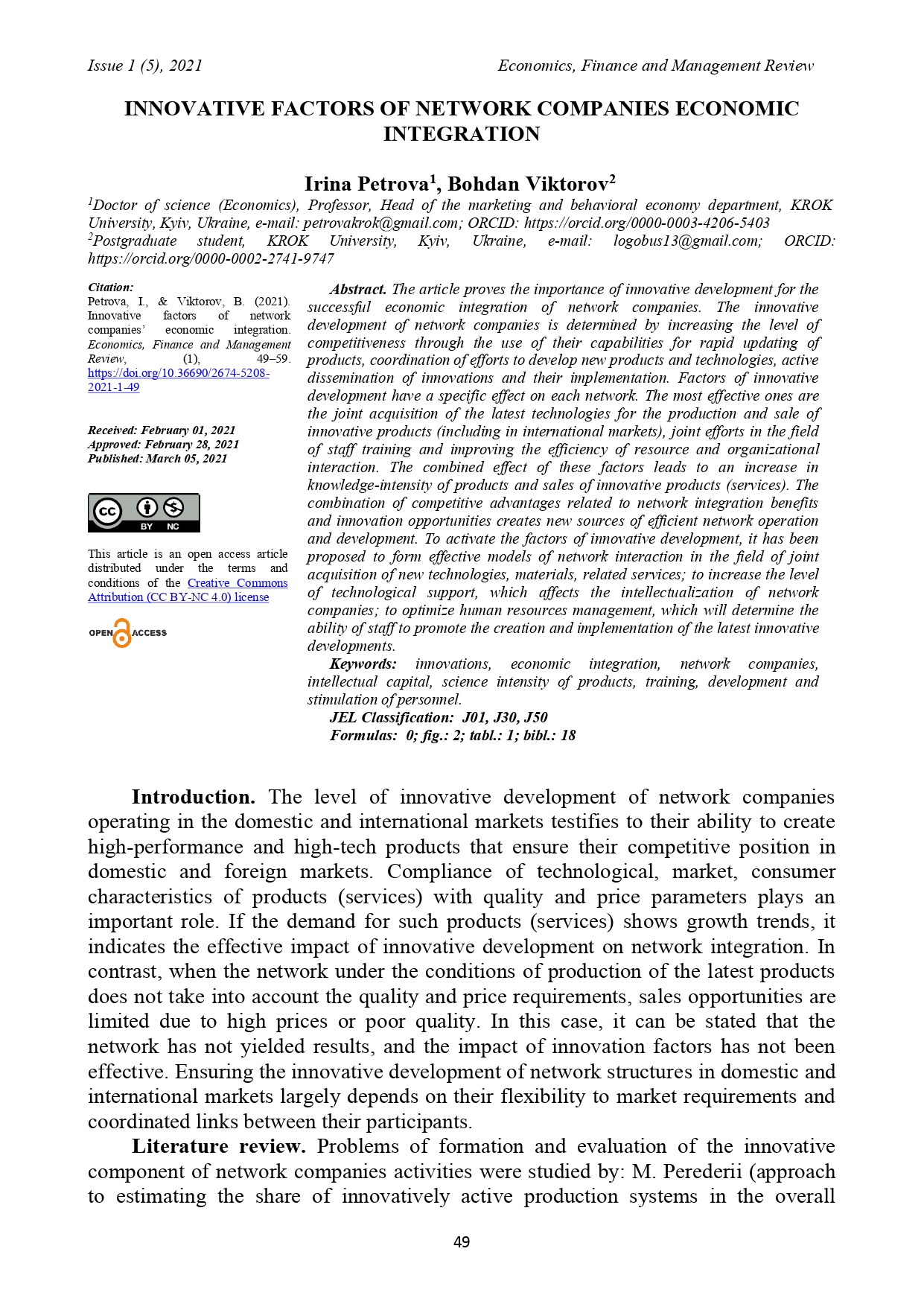INNOVATIVE FACTORS OF NETWORK COMPANIES ECONOMIC INTEGRATION
DOI:
https://doi.org/10.36690/2674-5208-2021-1-49Keywords:
innovations, economic integration, network companies, intellectual capital, science intensity of products, training, development and stimulation of personnelAbstract
The article proves the importance of innovative development for the successful economic integration of network companies. The innovative development of network companies is determined by increasing the level of competitiveness through the use of their capabilities for rapid updating of products, coordination of efforts to develop new products and technologies, active dissemination of innovations and their implementation. Factors of innovative development have a specific effect on each network. The most effective ones are the joint acquisition of the latest technologies for the production and sale of innovative products (including in international markets), joint efforts in the field of staff training and improving the efficiency of resource and organizational interaction. The combined effect of these factors leads to an increase in knowledge-intensity of products and sales of innovative products (services). The combination of competitive advantages related to network integration benefits and innovation opportunities creates new sources of efficient network operation and development. To activate the factors of innovative development, it has been proposed to form effective models of network interaction in the field of joint acquisition of new technologies, materials, related services; to increase the level of technological support, which affects the intellectualization of network companies; to optimize human resources management, which will determine the ability of staff to promote the creation and implementation of the latest innovative developments.
Downloads
References
Hadzevych, O., & Matviichuk, I. (2017). Methods of analysis and evaluation of innovative activities of the enterprise. Economic Journal of the Lesia Ukrainka East European National University, 3, 100-106.
Guan, J., & Ma, N. (2003). Innovative capability and export performance of Chinese firms. Technovation, 23(9), 737-747.
Hevko, V. (2018), The main aspects of organization of chain-style enterprises. Ekonomika ta derzhava, 7, 67–69.
Hittmar, S., Varmus, M., & Lendel V. (2015). Proposal of Evaluation System for Successful Application of Innovation Strategy through a Set of Indicators. Procedia Economics and Finance, 26, 17-22.
Izhevskyi, P.G. (2016). Entrepreneurial networks as a condition for economic modernization of enterprises. Economy and society, 3, 193-197.
Маhomedova, А.М. (2012). Prerequisites for the development of network structures in the national economy. Theoretical and applied issues of economics, 27, 375-379.
Marešová, P., Jašíková, V., Bureš, V. (2014). Multi-criteria Model for Evaluation of Cluster Initiatives: the Comparative Case Study. Procedia - Social and Behavioral Sciences, 109, 1242-1246.
McPhillips, М. (2019). Rola innowacji otwartych w klastrach (22 s.). Gdańsk, Polska.
Nikulina, O.V. (2011). Stimulation of innovative activity of industrial enterprises in the conditions of formation of an innovation cluster. National Interests: Priorities and Security, 17 (117), 37-47.
Parubets, O.M. (2016). Research of the essence of network associations of transport as an economic category. Technological audit and production reserves, 1/3(27), 37-40.
Perederii, M.V. (2016). Management of the formation and development of innovative industrial infrastructure in the context of reindustrialization. Extended abstract of Doctor’s thesis. Novocherkassk, Russia.
Smoliar, L.G., & Kotenko, O.A. (2012). Network structures as a modern form of organization of economic activity. Efficient economy, 12, 92-95.
Sushchenko, O.A., & Buzdakov, L.M. (2011). Development of management of network forms of interaction of business structures. Project management and production development, 3(39), 52–56.
Utami Handayani, N., Cacravatia, A., Diawati, L., & Nur Bahagia, S. (2012). A conceptual assessment model to identify phase of industrial cluster life cycle in Indonesia. Journal of Industrial Engineering and Management, 5(1), 198-228.
Vailunova, Y.H. (2014). Network structures and their role in increasing the competitiveness of enterprises. Economy and banks, 2, 53-60.
Vertakova, Y.V. (2009). Using a network approach to ensure the sustainability of the development of entrepreneurial structures in an economic crisis. InVestRegion, 2, 36–43.
Zen, A. C., & Fracasso, E. M. (2012). Recursos, competências e capacidade de inovação: Um estudo de múltiplos casos na indústria eletroeletrônica no Rio Grande do Sul. Revista de Administração e Inovação, 9(4), 177-201.
Zimmer, B., Cardinal, Julie Stal-Le, Yannou, B., & Piette F. (2013). A methodology for the development of innovation clusters: Application in the health care sector. International Journal of Technology Management, 66(1), 57-78.

Downloads
Published
How to Cite
Issue
Section
License

This work is licensed under a Creative Commons Attribution-NonCommercial 4.0 International License.








